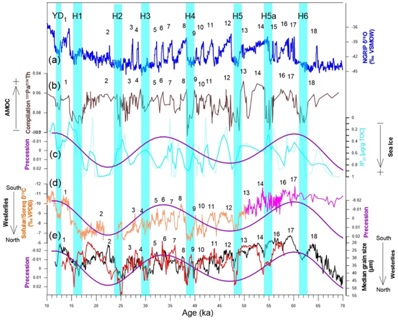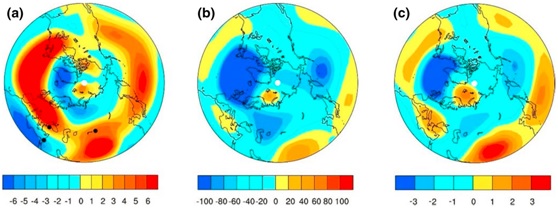Westerlies are one of the major components of the large-scale atmospheric circulations, which exerta huge influence on the global climate by modulating the transport and distribution of momentum, heat, and moisture. The northern westerlies particularly play a key role in reshaping precipitation patterns in mid-latitudes due to changes in their position and intensity. However, the evolution history of the westerlies is less well known and the drivers are still enigmatic.
Recently, research group for Central Asian loess led by Prof. SONG Yougui from Institute of Earth Environment, Chinese Academy of Sciences, presented a latitudinal-shift record of the northern westerlies in the past 70,000 years, based on two eolian loess sections in the westerly-dominated Central Asia. These findings had been online in Climate Dynamics. By comparison with records of the Mediterranean Sea speleothems, the North Greenland ice core, the Atlantic meridional overturning circulation (AMOC), and sea ice in the North Atlantic and by combination with two sensitivity experiments and a transient simulation, this group investigated the physical mechanisms of millennial- and orbital-scale variations of the westerlies. This work opened a detailed picture on the mid-westerly variability and paleoclimatic changes in Central Asia.
The group considered the loess grain size throughout the sections as the latitudinal shift of the westerlies in various timescales, distinct from previous studies,with increased grain sizes attributed to northward displacement of the westerlies. With the reliable optically stimulated luminescence (OSL) dating results, it was found that increases of grain size of the loess sections at the millennial-scale corresponded well to the North Atlantic events H1-H6, cooling over Greenland, weaker AMOC and a northern shift of the westerlies in the Mediterranean Sea and the Central Asia (Fig.1). Moreover, many of the Dangsgaard–Oschger warm events (DO 1–18) in the Greenland ice core were also well recorded (Fig. 1). At the orbital timescale, the variations in the westerlies over Central Asia and the Mediterranean Sea followed well precession, with a northward shift of the westerlies corresponding to larger precession index.
To further examine the forcing mechanisms of variations of the northern mid-latitude westerlies, the group analyzed differences in responses of the mid-latitude westerlies to AMOC between the Henrich 1 (H1) and the B?lling–Aller?d (BA) events using only freshwater-forcing results from the TraCE-21 ka transient simulation(Fig.2). The results showed that the slowdown of the AMOC weakened the global northward ocean heat transport, and induces the dipole SST anomaly in the Atlantic. As a result, temperatures in the high-latitude of Northern Hemisphere deceased, leading to an increase in the meridional temperature gradient and a high-pressure anomaly in the middle latitude and a low pressure one over the pole. These led to a northward displacement of the westerlies in the mid-latitudes at 500 hPa. At the orbital time scale, with two sensitivity experiments in the LOVECLIMand CCSM3 models, the group demonstrated that variations in winter (summer for pole region) insolation caused by precession led to latitudinal temperature gradient changes. A larger latitudinal pressure gradient was linked to a larger latitudinal temperature gradient between the high and mid-latitudes, which simulated a northward displacement of the westerlies. Therefore, the geological records and models’ results suggested that the impact of insolation and AMOC on the latitudinal shift of the westerlies was through changing the latitudinal temperature and pressure gradients.
This study expounded the forcing mechanisms of changes in mid-westerlies in Central Asia at different timescales and the relations with global climate for the first time. These findings not only facilitated prediction of climate change in Central Asia in the future, but had great significance in science in terms of revealing origins of teleconnections between East Asia and North Atlantic Ocean and interaction between westerly and monsoon.

Fig.1 The last glacial data comparison. a NGRIP δ18O (blue), b AMOC proxy(brown), c Sea ice (cyan), d Sofular/Soreq δ13C(orange/pink), and e Median grain sizeof Tacheng and Yumin (blackand red), and theprecession (purple). Sky-blue bars denote theHeinrich-like events identifiedin the six records. Black numbers (1–18, 10–70 kyr)denote well aligned DO eventsidentified in the four records.(Image by Li et.al )

Fig.2 The difference between H1 and BA in the zonal winds (m/s)(a), geopotential (m2/s2) (b) and air temperature (°C) (c) at 500 hPa during winter (Dec–Jan–Feb). (Image by Li et.al )
This work was supported by funds from the National Natural Science Foundation of China, and the Fonds de la Recherche Scientifque-FNRS.
Contact: Contact: Bai Jie, Institute of Earth Environment, Chinese Academy of Sciences, Xi'an, China. Email: baijie@ieecas.cn
 © 2015 Institute of Earth Environment,CAS
© 2015 Institute of Earth Environment,CAS Address:No. 97 Yanxiang Road, Xi'an 710061, Shaanxi, China

 Location :
Location :